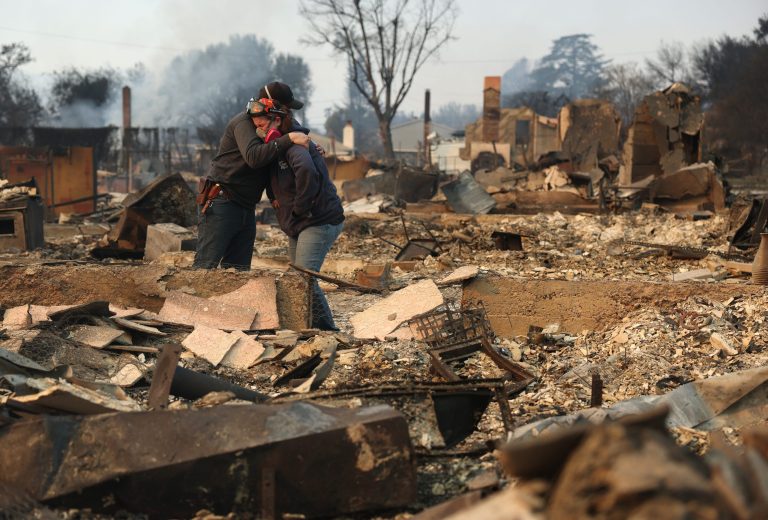The rapid spread and intensity of wildfires affecting the Los Angeles area due to extreme weather conditions and a prolonged drought have drawn state and national attention. Amid the crisis, President-elect Donald J. Trump accused California Gov. Gavin Newsom of mismanaging fires, stoking debate over the state's responsibility and the impact of climate change.
In a message posted on the Truth social networking site, Trump called Newsom “incompetent” and accused him of blocking the water supply in the southern part of the state to protect an endangered fish.
“Governor Gavin Newscum has refused to sign a water restoration declaration submitted to him that would have allowed millions of gallons of water (from excess rainfall and snowmelt in the north) to flow daily to many areas of California, including currently Burning area.
Newsom's office issued a blunt rebuttal. “There is no documentation of the purported water supply restoration announcement; it is pure fiction,” Newsom's communications director Izzy Gardon declared in a written statement. “The governor is focused on protecting people, not playing politics, and making sure firefighters have all the resources they need.”
Sacramento-San Joaquin Delta: Key to water supply, but not fire
The Sacramento-San Joaquin Delta is a critical hub for California's water supply. This vast network of wetlands and waterways connects the Sacramento and San Joaquin rivers to the San Francisco Bay, carrying water from the northern to the southern parts of the state. Its functionality is vital for agriculture, urban consumption and the protection of fragile ecosystems.
Despite the delta's importance, its management has been a subject of controversy, particularly with regard to protecting the delta region. delta smeltA small endemic fish whose numbers have declined so drastically that it has been added to the endangered species list. Their situation reflects the challenge of balancing human needs with environmental protection.
Trump claimed that water from the Sacramento-San Joaquin Delta in Northern California could be used to fight fires in Los Angeles, however, much of the water supplying the city does not come from the region. Los Angeles relies primarily on the Los Angeles Aqueduct, built in 1913, which carries water from the Owens Valley east of the Sierra Nevada Mountains.
Los Angeles fires: a phenomenon caused by climate change
Caitlin Trudeau, senior climate science researcher at the Climate Center, clarified to YCC that the Los Angeles fires were caused by extreme weather. “California's recent wildfires are caused by a combination of natural and man-made factors. Climate change has exacerbated long-term droughts, leaving vegetation dry and highly flammable. These conditions, exacerbated by climate change, create a world where fires can spread quickly and erratically. environment.
California has seen a significant increase in wildfires in recent decades, a trend that experts attribute to climate change. Between 1971 and 1995, the average area burned per year was 361 square kilometers; since 1996, this number has increased fivefold each year to 1,710 square kilometers.
California's average temperature has risen by about one and a half degrees Celsius since the onset of human activities that produce greenhouse gas emissions primarily through the burning of fossil fuels.
Trudeau highlighted the role of Southern California's unique Santa Ana winds in exacerbating the fires. “Strong winds fan the flames and create new sources of fire,” he explains. Severe Santa Ana winds sparked fires in the Los Angeles area this week. On Wednesday, January 8, at least 32 weather stations recorded wind gusts in excess of 70 mph (112 km/h), with the maximum gust of 100 mph (161 km/h) about 32 kilometers north of the Lukens Mountain Truck Trail. km/h).
Mark Gold, director of water scarcity at the Natural Resources Defense Council and a board member of the Metropolitan Water District of Southern California, called it irresponsible to link management of the Bay Delta region to devastating wildfires. He emphasized that the Metropolitan Water District currently has the largest water storage capacity in history. In addition, he emphasized that the real cause of the fires was not the lack of water in the north, but the persistent and devastating effects of climate change. These statements were made by Alastair Brand in an article published on CalMatters.
Climate change as a catalyst
“Climate change is significantly exacerbating the conditions that trigger wildfires and increasing the frequency of fire weather in California,” Trudeau stressed. Warmer temperatures will dry out soil and vegetation, leaving more fire fuel, he explained. He also pointed out: “Increasingly intense heat waves not only affect vegetation, but also affect the resistance of trees, making them vulnerable to pests and diseases.”
Additionally, he explained that some areas see fires almost year-round as warmer springs and delayed fall extend high-risk periods.
What does the future require?
In the face of political criticism of the country's management, experts such as Caitlin Trudeau insist that concrete measures are needed to address the root causes of the fires. “Effective land management is critical to reducing wildfire risk,” Trudeau said, highlighting practices such as prescribed burning that can limit available fuels and reduce fire intensity.
However, he warned that these burns require specific weather conditions that are “basically the opposite of fire-friendly weather,” making their implementation difficult because of the growing impacts of climate change. Trudeau stressed that the scale of California's problem, with millions of acres of land to deal with, requires long-term commitment and effective coordination. Additionally, he stressed the importance of protecting vulnerable communities through a comprehensive approach that includes clear evacuation plans, multilingual alert systems and equitable access to resources such as education programs, housing improvements and mental health services. “When we can no longer be guided by past experience, it will become increasingly difficult to prepare for the future,” he concluded, urging significant reductions in carbon emissions as part of a global strategy to address these challenges.
